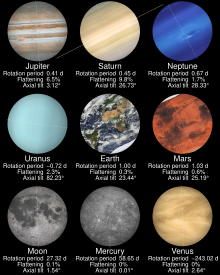The rotation period of a celestial object (e.g., star, gas giant, planet, moon, asteroid) is the time that the object takes to complete a single revolution around its axis of rotation relative to the background stars. It differs from the object’s solar day, which may differ by a fractional rotation to accommodate the portion of the object’s orbital period during one day.
Measuring rotation
For solid objects, such as rocky planets and asteroids, the rotation period is a single value. For gaseous or fluid bodies, such as stars and gas giants, the period of rotation varies from the object’s equator to its pole due to a phenomenon called differential rotation. Typically, the stated rotation period for a gas giant (such as Jupiter, Saturn, Uranus, Neptune) is its internal rotation period, as determined from the rotation of the planet’s magnetic field. For objects that are not spherically symmetrical, the rotation period is, in general, not fixed, even in the absence of gravitational or tidal forces. This is because, although the rotation axis is fixed in space (by the conservation of angular momentum), it is not necessarily fixed in the body of the object itself. As a result of this, the moment of inertia of the object around the rotation axis can vary, and hence the rate of rotation can vary (because the product of the moment of inertia and the rate of rotation is equal to the angular momentum, which is fixed). For example, Hyperion, a satellite of Saturn, exhibits this behaviour, and its rotation period is described as chaotic.
Earth
|
|
This section may be too technical for most readers to understand. (May 2015) (Learn how and when to remove this template message)
|
Earth’s rotation period relative to the Sun (its mean solar day) consists of 86,400 seconds of mean solar time, by definition. Each of these seconds is slightly longer than an SIsecond because Earth’s solar day is now slightly longer than it was during the 19th century, due to tidal deceleration. The mean solar second between 1750 and 1892 was chosen in 1895 by Simon Newcomb as the independent unit of time in his Tables of the Sun. These tables were used to calculate the world’s ephemerides between 1900 and 1983, so this second became known as the ephemeris second. The SI second was made equal to the ephemeris second in 1967.
Earth’s rotation period relative to the fixed stars, called its stellar day by the International Earth Rotation and Reference Systems Service (IERS), is 86164.098 903 691 seconds of mean solar time (UT1) (23h 56m 4.098 903 691s). Earth’s rotation period relative to the precessing or moving mean vernal equinox, its sidereal day, is 86164.090 530 832 88seconds of mean solar time (UT1) (23h 56m 4.090 530 832 88s). Thus the sidereal day is shorter than the stellar day by about 8.4 ms. The length of the mean solar day in SI seconds is available from the IERS for the periods 1623–2005 and 1962–2005. Recently (1999–2005) the average annual length of the mean solar day in excess of 86400 SI seconds has varied between 0.3 ms and 1 ms, which must be added to both the stellar and sidereal days given in mean solar time above to obtain their lengths in SI seconds.
Rotation period of selected objects

Comparison of the rotation period (sped up 10 000 times, negative values denoting retrograde), flattening and axial tilt of the planets and the Moon (SVG animation)
| Celestial objects | Rotation period with respect to distant stars, the sidereal period (compared to Earth days) | Apparent rotational period viewed from Earth, the synodic period |
|
|---|---|---|---|
| Sun | 25.379995 days (Carrington rotation) 35 days (high latitude) |
25ᵈ 9ʰ 7ᵐ 11.6ˢ 35ᵈ |
~28 days at its equator |
| Mercury | 58.6462 days | 58ᵈ 15ʰ 30ᵐ 30ˢ | |
| Venus | −243.0187 days | −243ᵈ 0ʰ 26ᵐ | |
| Earth | 0.99726968 days | 0ᵈ 23ʰ 56ᵐ 4.0910ˢ | |
| Moon | 27.321661 days |
27ᵈ 7ʰ 43ᵐ 11.5ˢ | 29.5 days (synchronous toward Earth) |
| Mars | 1.02595675 days | 1ᵈ 0ʰ 37ᵐ 22.663ˢ | |
| Ceres | 0.37809 days | 0ᵈ 9ʰ 4ᵐ 27.0ˢ | |
| Jupiter | 0.4135344 days (deep interior) 0.41007 days (equatorial) 0.41369942 days (high latitude) |
0ᵈ 9ʰ 55ᵐ 29.37s 0ᵈ 9ʰ 50ᵐ 30ˢ 0ᵈ 9ʰ 55ᵐ 43.63ˢ |
|
| Saturn | 0.44403 days (deep interior) 0.426 days (equatorial) 0.443 days (high latitude) |
0ᵈ 10ʰ 39ᵐ 24ˢ 0ᵈ 10ʰ 14ᵐ 0ᵈ 10ʰ 38ᵐ |
|
| Uranus | −0.71833 days | −0ᵈ 17ʰ 14ᵐ 24ˢ | |
| Neptune | 0.67125 days | 0ᵈ 16ʰ 6ᵐ 36ˢ | |
| Pluto | −6.38718 days |
–6ᵈ 9ʰ 17ᵐ 32ˢ | |
| Haumea | 0.163145 days | 0ᵈ 3ʰ 54ᵐ 56ˢ | |
